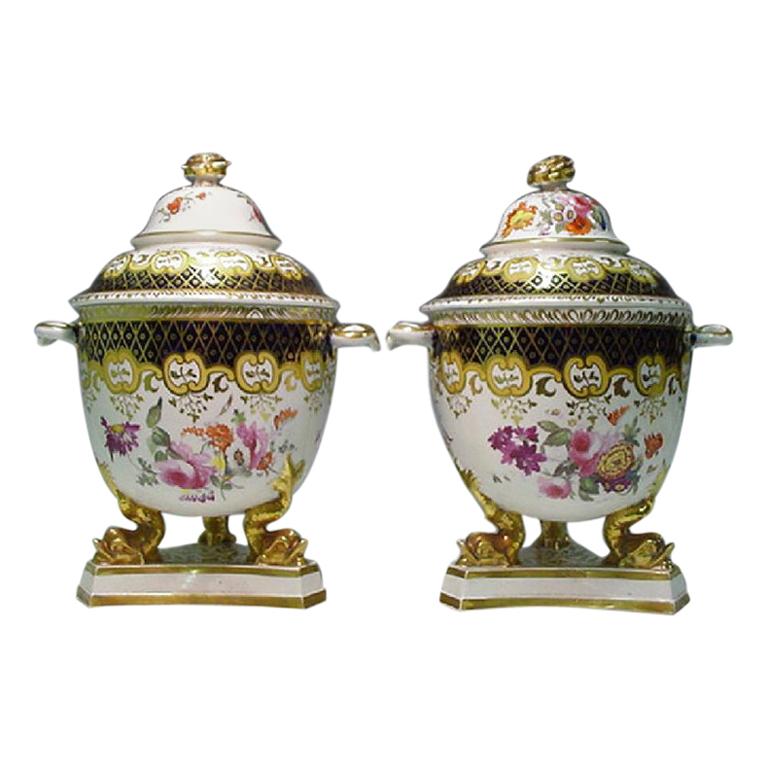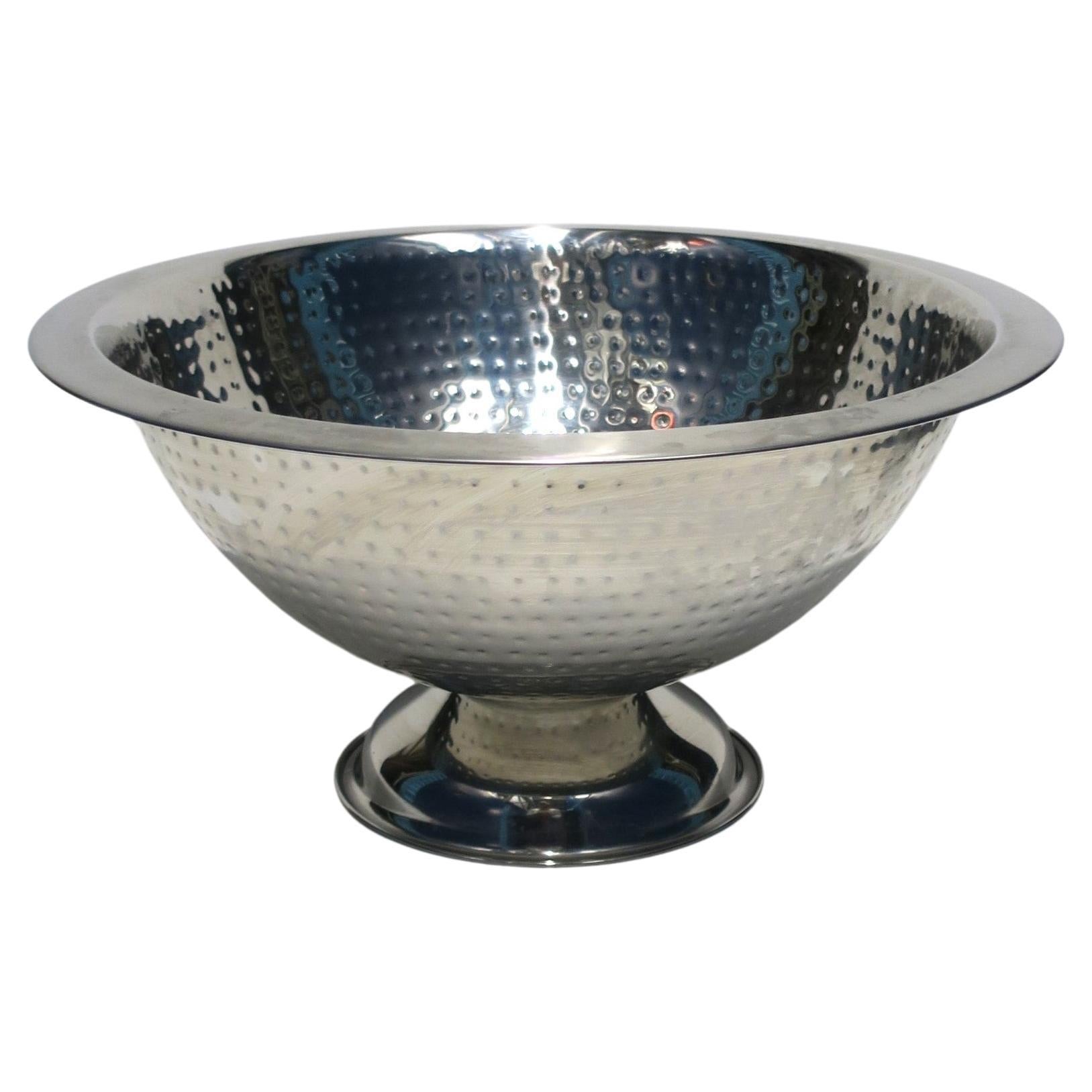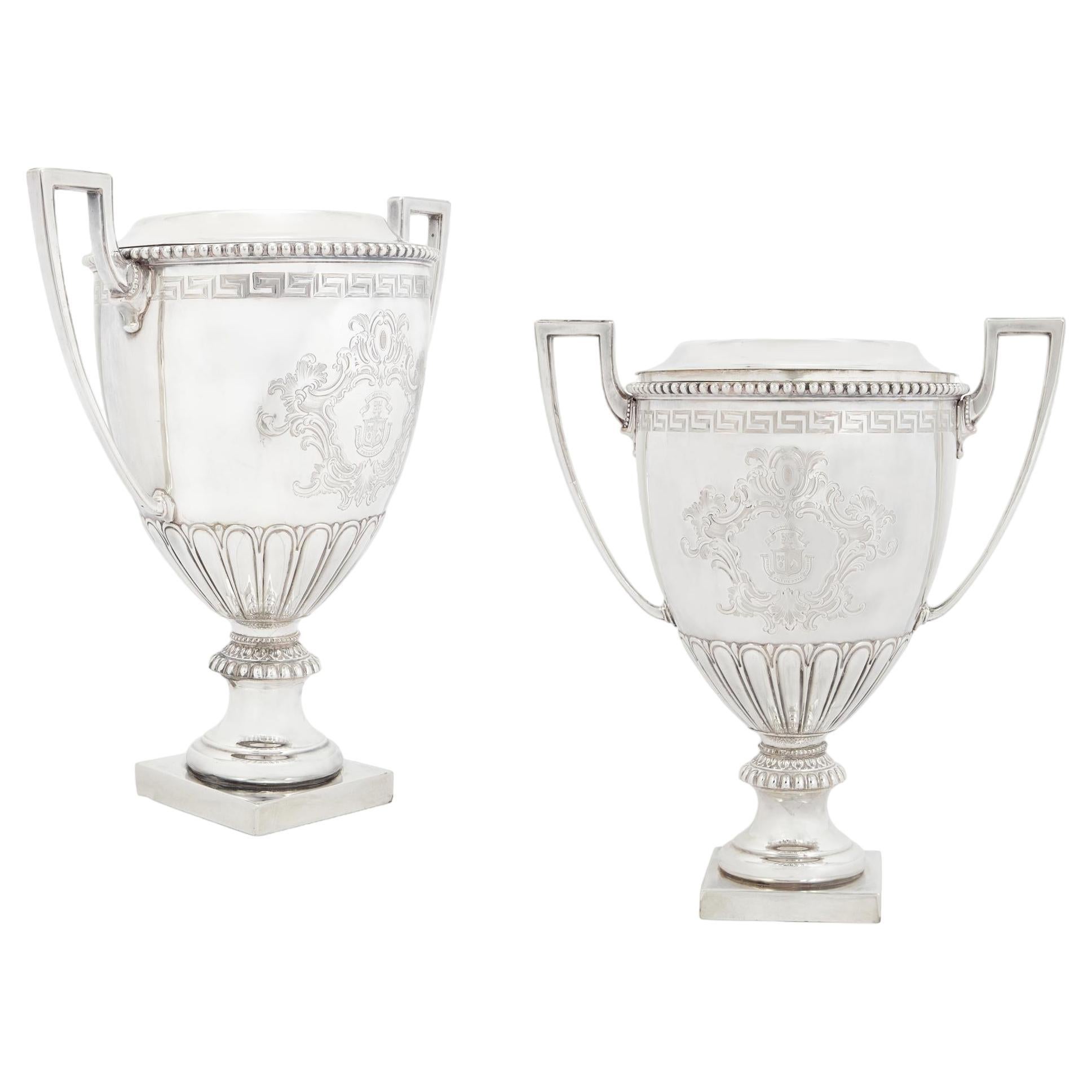Items Similar to Pair of Porcelain Urn Form Fruit Coolers with Covers and Liners
Want more images or videos?
Request additional images or videos from the seller
1 of 6
Pair of Porcelain Urn Form Fruit Coolers with Covers and Liners
About the Item
Pair Footed Fruit Coolers, about 1810-20
Stône, Coquerel, and Legros D’Anisy, Paris (active 1808–49)
Porcelain, partially transfer printed in sepia and green and gilded
Each, 13 1/2 in. high x 10 in. wide x 7 1/2 in. deep
Signed and inscribed (on underside of one top and one base, with printed mark): STÔNE /
COQUEREL / ET / LE GROS / PARIS / PAR BREVET D’INVENTION: Manufre de Décors sur
Porcelaine Faience; variously inscribed with decorators’ initial in green and brown (on
underside of one top and one base): M; variously inscribed with incised mark (on underside of one liner and both bottoms): 3; inscribed (in blue script, on the inside of one liner): 615
The Parisian firm of Stône, Coquerel, and Legros d'Anisy is distinguished for the important role that it played in the introduction of transfer-printed decoration on fine china in France. Although the process had been known and used in Great Britain since the eighteenth century, it was, according to Régine de Plinval de Guillebon in her book, Porcelain of Paris 1770–1850 (New York: Walker and Company, 1972), not until 1802 that Potter, Blancheron, Constant, Neppel, Cadet de Vaux & Denuelle took out a patent in France for transfer-printing on earthenware, and it was only on February 26, 1808, that John Hurford Stône, his brother-in-law, Athanase Marie Martin Coquerel, and Francois Antoine Legros d'Anisy not only took out a patent for transfer-printing on china, but also established a Stône, Coquerel, and d'Anisy partnership for the manufacture of transfer-printed ceramics. Their address from 1808 until 1818 was at 9, rue de Cadran, Paris.
Prior to this, Stône and Coquerel had been partners at a creamware factory in Creil, France, and Legros d’Anisy had worked at the Sèvres factory, where he had apparently developed the transfer-printing technique for which his own firm became well known. “The process,” notes de Guillebon, was “based upon removing from the engraving a ‘pull’ made on a specially coated filter-paper, which was pressed onto the object to be decorated; this object itself was covered with a film. Firing took place in a muffle-kiln” (p. 262). Stone “was responsible for management and general supervision, ... Coquerel was just a signatory [and], as for Legros d'Anisy, the technician, his tasks were to select suitable subjects for reproduction, to fix prices, and to choose and manage the painters and engravers.”
De Guillebon (p. 264) cites the Almanach du Commerce de la Ville de Paris of 1808, which listed the various subjects that were used by the firm of Stône, Coquerel, and d'Anisy, including the fables of La Fontaine, portraits of great men both ancient and modern, picturesque views, castles and country houses in different lands, highlights from French and Roman history, monuments of Paris and its environs, engraved stones, and military service. The Almanach further noted that “all these decorations could be turned out in black or in colour, and this applies equally to any subjects that might be requested: monograms, armorial bearings, family portraits, etc.”
In contrast to the clumsy decorative effects often resulting from the transfer-printing process, the decorations of Stône, Coquerel, and d'Anisy were “remarkable for their delicacy and clarity” (de Guillebon, p. 264), which is confirmed not only by the splendid quality of the present pair of coolers, but also by the huge assortment of subjects used to decorate their wares. Complementing the transfer-printed scenes, these coolers are adorned with a variety of neo-classical borders–floral, foliate, and geometric–both transfer-printed and free drawn.
- Creator:Stône, Coquerel, and Legros d'Anisy (Artist)
- Dimensions:Height: 13 in (33.02 cm)Width: 10 in (25.4 cm)Depth: 7 in (17.78 cm)
- Sold As:Set of 2
- Style:Neoclassical (In the Style Of)
- Materials and Techniques:
- Place of Origin:
- Period:
- Date of Manufacture:circa 1810-1820
- Condition:Repaired: A chip to the underside of the rim of one liner was expertly and invisibly repaired. Wear consistent with age and use. Excellent. Unlike many coolers of the period, these retain their original covers and liners. Some minor wear to the gilding and decoration as expected due to age.
- Seller Location:New York, NY
- Reference Number:
About the Seller
No Reviews Yet
Recognized Seller
These prestigious sellers are industry leaders and represent the highest echelon for item quality and design.
Established in 1952
1stDibs seller since 2010
Typical response time: 1 to 2 days
Associations
Art Dealers Association of America
- ShippingRetrieving quote...Ships From: New York, NY
- Return PolicyThis item cannot be returned.
More From This SellerView All
- Pair of “Old Paris” Porcelain Coolers, Yellow Bands, Floral WreathsBy Darte FrèresLocated in New York, NYDarte Frères, Paris, made, circa 1820. Porcelain, partially painted and gilded. Measures: 14 1/4 in. high, 10 3/8 in. wide (through the handles), 7 3/4 in. deep. Signed (with stencil, in black, on the bottom of each): Darte. f. Recorded: cf. Régine de Plinval de Guillebon, Porcelain of Paris, 1770–1850 (New York: Walker and Company, 1972), p. 333 no. 79 illustrates the mark on these coolers. Some of the most beautiful porcelain produced in Paris during the Empire/Restauration periods was made or sold by the firm of Darte Frères. Although the Darte family, which came from Namur, then in The Netherlands, had set themselves up in the business of the manufacture of porcelain as early as 1794–95, by 1803 the three Darte brothers had decided, as Régine de Plinval de Guillebon notes (ibid., p. 231), that “each should have his own establishment,” and, indeed, by 1804 their prior business partnership had been “annulled,” and from that point forward there were two businesses using the name Darte. The Darte brothers, Louis Joseph and Jean François, began independent operation in 1804 at the Hôtel Montalembert, at 90, rue de la Roquette. Their business arrangements were only formalized in 1808, at which time they began to use the name “Darte Frères.” They remained in the business until 1825, when their partnership was dissolved. Darte Frères produced a large variety of porcelain, including vast dinner and...Category
Antique 19th Century Empire Wine Coolers
MaterialsPorcelain
- Pair of Medici-Form VasesLocated in New York, NYAttributed to Schoelcher, Paris, France, circa 1830. Porcelain, painted and gilded. 16 1/4 in. high, 9 1/2 in. wide, 9 1/2 in. deep. Ex Coll.: by repute, Joseph Bonaparte...Category
Antique Mid-19th Century French Empire Porcelain
MaterialsPorcelain
- Pair of 'Old Paris' Porcelain Vases with Drapery DecorationLocated in New York, NYFrench Pair “Old Paris” Porcelain Vases with Drapery Decoration, about 1820 Porcelain, painted and gilded 13 1/16 in. high CONDITI...Category
Antique 1820s French Empire Vases
MaterialsPorcelain
- Set of 16 Klismos-Form Dining ChairsLocated in New York, NYBoston, Massachusetts, circa 1820. Mahogany (secondary woods: Birch and maple; slip seats: Birch and pine) Measures: 33 1/4 in. high, 18 5/8 in. wide, 19 ¼ in. deep (overall). Ex Coll: Private collection, until 2004; to [Hirschl & Adler Galleries, 2004]; to private collection, 2004 until the present. Exhibited: Hirschl & Adler Galleries, New York, 1999–2000, Boston in the Age of Neoclassicism, 1810–1840, p. 57 no. 21D illus. in color // Hirschl & Adler Galleries, New York, 2001–2002, of the Newest Fashion: Masterpieces of American neoclassical Decorative Arts, pp. 93 cat. 26, 95 illus. in color two chairs from the set / Hirschl & Adler Galleries, New York, 2014-2015, very rich and handsome, p. 30 no. 5 illus. in color two chairs from the set. One of the signature forms of furniture of the neoclassical period in the United States is the klismos chair as interpreted by a group of Boston cabinetmakers in the period circa 1820 (see Page Talbott, “Seating Furniture in Boston, 1810–1835,” The Magazine Antiques CXXXIX [May 1991], pp. 966ff.). These chairs are usually characterized by sabre legs at the front and the back and curved crest rails typically enriched with flaming mahogany veneers, their ends often punctuated by stylized leaves, anthemia, or scrolls, and center splats decorated with leaves, drapery, lyres, etc. Just as it is easy to identify a New York or Philadelphia side, or dining, chair of the period, so Boston chairs have a certain “look” that sets them apart from chairs from all other American cabinetmaking centers in this period. The sumptuous nature of the lotus bud and tulip-carved swags which form the back splats of these chairs is offset by the simplicity of the crest rail, in which oval veneered panels are encircled by a raised molding, and by the reeded stiles which seamlessly sweep down to become first the side-rails and then the front legs of the chairs. Although the form of these chairs relates them to many comparable Boston examples of the period, none of these other chairs feature the paw feet that terminate the front legs of the present set of chairs, a feature that appears to be otherwise unknown on Boston side chairs...Category
Antique 19th Century American Neoclassical Dining Room Chairs
MaterialsMahogany
- Pair of "Old Paris" Vases with Garlands of Bisquit FlowersLocated in New York, NYFrench, circa 1820. Porcelain, painted and gilded, with applied bisquit flowers 8 13/16 in. high. Inscribed (with incised mark, under the base of each): 3.Category
Antique 1820s French Neoclassical Porcelain
MaterialsPorcelain
- Monumental Clear Cut-Glass Covered CompoteLocated in New York, NYMonumental clear cut-glass covered compote, circa 1820. La Cristallerie de Vonêche (active 1802-30), Belgium. Glass, blown and cut. Measures: 17 3/8 i...Category
Antique Early 19th Century Belgian Neoclassical Tableware
MaterialsBlown Glass, Cut Glass
You May Also Like
- Regency Ridgway Porcelain Fruit Coolers, Covers and LinersBy Ridgway PorcelainLocated in Downingtown, PAThe Ridgway porcelain coolers are decorated in pattern #1173. They have a circular body raised on three dolphin feet and trefoil base and painted with flo...Category
Antique Early 19th Century English Regency Serving Pieces
MaterialsPorcelain
- Champagne Wine Cooler or Ice Bucket Urn FormLocated in New York, NYA relatively large round metal Champagne wine cooler or ice bucket in an urn form with hammered design, circa 21st century. A great piece for Cham...Category
21st Century and Contemporary Wine Coolers
MaterialsMetal
- Pair Of English Neoclassical Style Electroplate Urn Wine Coolers, 20th CenturyLocated in West Hollywood, CAA Pair Of English Neoclassical Style Electroplate Urn Form Wine Coolers, 20th Century Engraved with coat of arms an motto Sourced from England by Martyn Lawrence BullardCategory
20th Century English Neoclassical Wine Coolers
MaterialsMetal
- Liner Champagne Cooler in Polished Stainless SteelLocated in Paris, FRChampagne cooler liner in polished stainless steel. Also available in wine cooler Liner.Category
21st Century and Contemporary Indian Wine Coolers
MaterialsStainless Steel
- English 1870s Oval Oak Planter or Wine Cooler with Brass Braces and LinerLocated in Atlanta, GAAn English oval oak planter from the late 19th century with brass braces and liner. Used as a wine cooler or a planter, this oval piece, strengthened with horizontal brass braces who...Category
Antique Late 19th Century English Planters and Jardinieres
MaterialsBrass
- Brass Pineapple Urn Beverage CoolerBy Maison JansenLocated in North Hollywood, CABrass pineapple urn beverage cooler.Category
Vintage 1970s Hollywood Regency Barware
Recently Viewed
View AllMore Ways To Browse
Wine France
Stone Top Pair
China Wine
Ancient Roman Stone
French Country Porcelain
Antique With Modern Decor
Modern Decor With Antique Furniture
Castle Stone
Reproduction Antique Glass
Stone Pull
Drawn Antique Glass
19th Century French Country Scene
Blue Gilt Urn
Antique Mens Glasses
Ancient Urn
Pairs Of French Porcelain Urns
Pair Of Gilded Urns
Stone Top Bar





